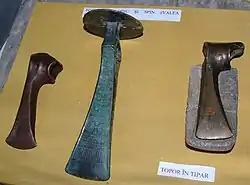Bronze Age in Romania
The Bronze Age is a period in the Prehistoric Romanian timeline and is sub-divided into Early Bronze Age (c. 3500–2200 BC), Middle Bronze Age (c.2200–1600/1500 BC), and Late Bronze Age (c. 1600/1500–1100 BC).[1]
| Bronze Age |
| ↑ Chalcolithic |
|
Africa, Near East (c. 3300–1200 BC) Indian subcontinent (c. 3300–1200 BC) Europe (c. 3200–600 BC)
Eurasia and Siberia (c. 2700–700 BC)
East Asia (c. 3100–300 BC) |
| ↓Iron Age |

Periodization
Several Bronze Age chronologies have been applied to the Romanian area. An example would be the Periodization of Paul Reinecke for the Central European space, which split the Bronze Age into four phases (A, B, C and D) based upon the associations among the found bronze objects.[1]
Features

During the Bronze Age, there were some important developments from Chalcolithic, with significant improvements in the economy.
The local bronze-aged economy was based on rearing livestock (sheep, goats and pigs). The Wietenberg culture reared large cattle and horses for both transportation and food. At this time, the artistic output also significantly increased, for example the Gârla Mare culture who created intricate clay statuettes.
In the Early Bronze Age (c. 3500–2200 BC), we see the archaeological evidence of various cultures developing, including the Baden-Coţofeni culture, the Cernavodă III-Belleraz culture, the Glina culture and the Verbicioara culture. Common occupations were agriculture, mining, and animal husbandry. Houses were rectangular and medium-sized. The last period of the Early Bronze Age produced a broad range of ornaments (loop rings, bracelets, necklaces, pendants comprising copper, gold, and silver and particularly bronze).
Verbicioara culture was identified in 1949 by the eponymous resort excavations. Regarding burial customs, it was considered the beginning of the burial of the dead.[2]
In the Middle Bronze Age (c.2200–1600/1500 BC), the population of Romania and neighboring countries was demarcated by the appearance of several major cultures. Some that stand out include the Otomani culture (seen also in Slovakia), Wietenberg culture (seen in Transylvania), Mureş culture, and Gârla Mare culture (from which impressive clay figurines and statuettes have been found).
Religion

The Bronze Age introduced solar, or Uranian, cults. Some ornaments, considered to be solar symbols, were frequently pictured on ceramic or metal parts: concentric circles, circles accompanied by rays, and the swastika. Cremation is considered to be connected to these cults.[3]
In the Romanian territory, there are three known bronze-aged sanctuaries: Sălacea, Bihor County (Ottomány culture, phase II), . The only cultures of this area well represented in this regard are the Gârla Mare Zuto Brdo culture and the Bijelo Szeremle Brdo-Dalj culture (also present in Hungary and Croatia). About 340 pieces were found in the area of the two cultures, of which 244 are in the Gârla Mare area.[3]
Clay miniature axes (axes, hammers or double axes) belonging to this period have been found. Labrys double-axes are frequently found in the Cretan and Mycenaean worlds, where they occur most often in complex rituals and tombs (for example the Tomb of double ax of Knossos). In the Mycenaean context, the labrys has a wide range of sizes, from miniature forms to giant forms that measure 1.20 meters. However, the labrys site is frequently associated with the moon and can be a symbol of a goddess of vegetation, the forerunner of Demeter, who, on Mycenaean seals, is found under a tree. The goddess has an ax in her hand and receives as gifts poppies and fruits.
See also
Notes
- Cristian Ștefan-Epoca Bronzului, page 1
- "Cu Privire La Descoperirile Funerare Ale Grupei Verbicioara". Archaeology.ro. 2004-12-09. Archived from the original on 2012-03-17. Retrieved 2012-02-09.
- "Credinte religioase si piese de cult in epoca bronzului - Prehistoire". Prehistoire.e-monsite.com. Archived from the original on 2011-09-13. Retrieved 2012-02-09.
References
- Cristian Ștefan - Epoca Bronzului
- Ioan Aurel-Pop, Ioan Bolovan, coordinatings - Istoria ilustrată a României
External links
| Wikimedia Commons has media related to Bronze Age in Romania. |